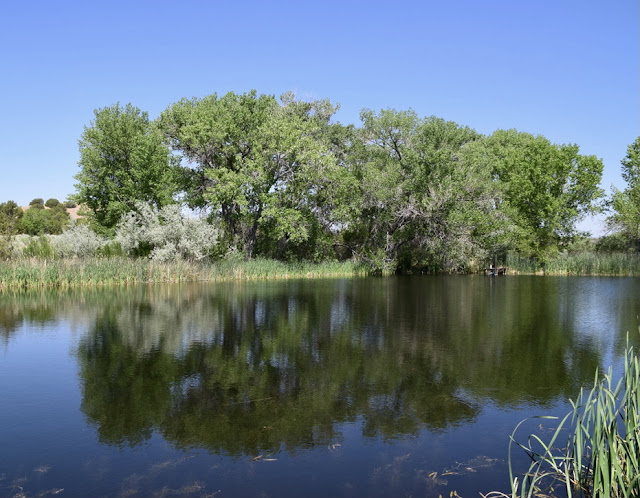Wetlands
This past weekend we spent a lovely morning at the Leonora Curtin Wetland Preserve. It's owned by the Santa Fe Botanical Garden, but is about 10 miles outside of town in an area called la cienega, or the spring-fed marsh in Spanish.
 |
| The spring fed pond |
The wetland preserve sits within a long valley of springs and creeks and grassy swamps that eventually feed into the lower part of the Santa Fe river before it meets the Rio Grande. Water, of course, attracted settlements for centuries -- first Pueblo villages and then Spanish ranchers and cattle farmers, now residential housing developments.
For centuries the shady, green, watered valley was a paraje, or stop, on the Camino Real -- the old road from Mexico. At 10 miles from the city, ranches and inns in la cienega were a day's wagon ride from town, so it was the last overnight stop before you got to Santa Fe, or the first stop of your journey on your way south.
 |
| Tunnels of shade |
For all its long history of human use, the villages of La Cienega and La Cieneguilla have remained rural feeling, just far enough outside of town. Carved out of the surrounding marshes, the wetland preserve is a delightful oasis.
Cottonwood trees are massive and the day we were there the cotton fluff had coated the ground like snow.
 |
| Cotton snow |
Cottonwoods, in the presence of underground water, become giants. I worry about the eventual size of the cottonwood outside our dining room window, already 60 feet tall but threatening to become something like this:
 |
| Big old gnarly cottonwoods were everywhere |
Unfortunately non native Russian olive trees have overtaken the wetlands and are choking out other species. They are big and stately in their own way, and the silver leaves are twinkly.
 |
| Russian olives have their own gnarly grace but are invasive |
But they suck water out of the wetlands, noticeably lowering the water table alarmingly when they leaf out in spring. Restoration workers are removing Russian olives and other invasive plants over a period of years.
 |
| Russian olives take up a lot of room and a lot of water |
At the end of a half mile walk through shade tunnels and sunny meadows, we came to the pond. What a refreshing sight.
 |
| A true oasis to see |
And of course there were darting jeweled dragonflies, ribbity bullfrogs, fish, birds, probably snakes too.
The water comes from far away in the Sangre de Cristo mountains, then trickles underground for thousands of years and many miles, bubbling up here and in other springs throughout la cienega.
 |
| We mostly had the place to ourselves |
The morning was pleasant, the pond was a sight for drought-accustomed eyes, the breeze was like a cool bath of air. The walk was level and short enough that Jim could manage it with his walking pole. The tight flock of birdwatchers with their binoculars and pungent sunscreen aromas passed us gabbling and chirping, and then left us to enjoy the wetlands by ourselves.
We had a very nice morning.
Comments